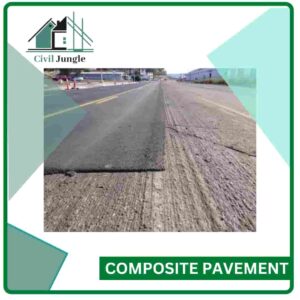What is Pavement?
Important Point
Pavement or carriageway, often referred to as the pavement meaning, is that part of the road or highway which supports the wheel loads imposed on it from traffic moving over it. Essentially, when one asks, ‘What is a pavement?‘, it refers to this supportive structure.
It ought to be strong enough to resist the stresses that are being developed as a result of traffic.
Pavement should also be thick enough to distribute the external loads on the earthen sub-grade so that sub-grade can safely bear these external loads.
The pavement consists of a few layers of pavement materials over a prepared soil sub-grade
Pavement consists of one or more layers.
A simple classification of layers as per Indian practice is shown in as per below fig. no-1.
Sub Grade Fig No-1
The surfacing is the topmost layer, which should be smooth, abrasion-resistant, dustproof, and strong.
The base course immediately below the surfacing is a medium to distribute the stress evenly.
The sub-base course gives additional help in distributing the stress.
Sub-grade is the compacted earth below the sub-base course. Pavement should be even. It should have light-reflecting materials for night visibility.
The layer surfacing is the topmost layer, which should be smooth, abrasion-resistant, dustproof, and strong.
The base course immediately below the surfacing is the medium to distribute the stress evenly.
Sub-base the base course that gives additional help in distributing the stress. Sub-grade is the compacted earth below the sub-base course. Pavement should be even.
It should have light-reflecting materials for night visibility.
Based on location, materials of construction, and other factors, roads are classified into different types, including the flexible and rigid pavement.
The flexible and rigid pavement difference lies in their construction materials and behavior under load, such as earth road, gravel road, water-bound macadam (WBM) road, bituminous or blacktop road, and cement concrete road.
Also, read: Core Cutter Method | What is Compaction of Soil
Useful Article for You
- What Is Composite Wood
- What Is the Difference Between a Shower Pan and a Shower Base?
- What Is Raft
- What Is a Window Panel
- What Is Rebar Made Of
- What Is Crane
- What Is a Frame Structure
- What Is the Measurement for a Queen Size Bed
- What Is Considered Livable Space
- What Is One Way You Can Save Electricity?
- What Is Mdf Mean
- What Is a Bundle of Shingles
- What Is a Gallon of Water Weigh
- What Is Window Sash
- What Is a Sieve Analysis
- What Is the Little Black Diamond on a Tape Measure
- What Is the Difference Between a Bolt and a Screw?
- What Is Overhang
- What Is Sand Blasting
- What Is a Walk in Basement
- What Is Pedestal
- What Is Bhk in India
Types of Pavement
This is classified from the point of structural behavior as:
- Flexible Pavement
- Rigid Pavement
- Semi-rigid Pavement
- Composite Pavement
1. Flexible Pavement
Flexible pavements are Such, which on the whole have Minimal or Low flexural strength and Therefore are rather flexible at their structural action under the loads
The flexible pavement layers reflect this deformation of these lower layers on-to that the top layer of the layer.
Therefore, if the lower layer of the pavement or soil subgrade is undulated.
The flexible pavement surface also gets undulated. Flexible pavement consists of four components :
- Subgrade (Prepared Road Bed).
- Subbase Course.
- Base Course.
- Surface Course.
The flexible pavement layers transmit this vertical or compressive stresses to the lower layers by grain transfer through the points of contact at the granular structure.
A well-compacted granular structure consisting of strong graded aggregate (interlocked aggregate structure with or without binder materials) can move the compressive stresses through a wider area, and so forms a good flexible pavement layer This load spreading ability of this layer, therefore, depends on the type of the mix design and the materials factors.
Bituminous concrete is among the best flexible pavement layer materials Other materials that fall under the group arc, All granular materials without a bituminous binder, granular base, and sub-base course materials such as the Water Bound Macadam, crushed gravel, aggregate, soil-aggregate mixes, etc.
The vertical compressive Pressure is equal to the pavement surface directly under the wheel load and also is equivalent to the contact pressure under the wheel because of the ability to distribute the pressures to a larger area from the shape.
Of a truncated cone, the pressures decreased at the lower layer
Hence by taking full advantage of the Pressure distribution characteristics of the flexible pavement, the layer system concept has been developed,
According to this. The flexible pavement might be constructed in many layers, and the top layer was the strongest as the highest compressive stresses should be sustained by this layer, along with the tear and wear as a result of the traffic.
The lower layers have into take up only lesser magnitudes of stresses, and there’s not any direct wearing action because of traffic loads.
Therefore inferior materials with lower cost can be used in the lower layers.
The lowest layer is the prepared surface consisting of the local soil itself, called the subgrade.
A typical cross-section of a flexible pavement structure is shown in as per below fig. no-1; this consists of a wearing surface on top, below which is the base course followed with the subbase course and the lowest layer consists of the soil subgrade that has the lowest stability one of the four typical flexible pavement components.
Each of the flexible pavement layers above the subgrade, viz. sub-base, base course, and the surface course may consist of one or more layers of the same or slightly different materials and specifications.
Also, read: What Is Cement | Types of Cement
2. Rigid Pavement
Rigid pavements are those that possess noteworthy flexural strength or flexural rigidity. The flexible pavement and rigid pavement difference is evident in how they transfer pressures.
In rigid pavements, the pressures aren’t transferred from grain with the lower layers, as in the case of flexible pavement layers.
The rigid pavements are made with Portland cement concrete-either plain, reinforced or prestressed concrete the plain cement concrete slabs are expected to take-up roughly 40 kg/sq. Cm. Flexural stress.
The rigid pavement has the slab action and is capable of transmitting the wheel load stresses through a wider area below.
- The main point of difference in the structural behavior of rigid pavement compared to the flexible pavement is the critical condition of stress from the rigid pavement ist that the maximum flexural stress was occurring from the slab because of wheel load and the temperature changes where-as from the flexible pavement It’s the distribution of compressive stresses.
- Since the rigid pavement slab has tensile strength, tensile stresses are developed due to the bending of the slab under a wheel load and temperature variations.
- So the types of pressures developed and their distribution inside the concrete slab that is concrete are quite different.
- The rigid pavement doesn’t get deformed into the shape of the surface as it could bridge the minor variations of the lower layer.
- The cement concrete pavement slab may very well serve as a wearing surface in addition to an effective base course.
- Therefore generally, the rigid pavement structure is made up of cement slab that is concrete, below that the granular base or sub-base-course can be provided (see above fig. 2).
- Although the cement concrete slab may also be laid directly over the soil subgrade, this isn’t preferred, particularly when the subgrade, consists of fine-grained soil.
- Supplying a good base or sub-base course layer below the concrete slab that is concrete increases the pavement life considerably and thus works out more economical in the long run.
- The rigid pavements are often designed, along with the stresses are analyzed using the elastic theory and assuming the pavement within an elastic plate resting over a elastic or a viscous foundation.
3. Semi-Rigid Pavement
When bonded materials like the pozzolanic concrete, lean cement concrete, or soil-cement are used in the base course or sub-base course layer, the pavement layer has considerably higher flexural strength than the common flexible layers.
However, these bonded materials do not possess as much flexural strength as the cement concrete pavements.
Therefore when this intermediate class of materials is used in the base or sub-base course layer of the pavements are either designed on experience, or by using a new design approach.
These semi-rigid pavement materials have a low resistance to impact and abrasion and therefore are usually provided with flexible pavement surface course.
4. Composite Pavement
A composite pavement consists of multiple structurally significant layers of different heterogeneous compositions.
A typical example is a brick sandwiched concrete pavement.
The top and bottom layers are of cement concrete, which sandwiches a bricklayer in the neutral axis zone.
Also, read: Piling for Foundation | Use of Pile Foundation | Characteristics of Pile Foundation
Useful Article for You
- Classification of Stone Work
- Stone Masonry vs Brick Masonry
- Cement Rate Today
- How to Get House for Free
- Top 10 Cement in India 2023
- Slab Reinforcement Calculation
- Steps for Construction of Building
- What Is Hempcrete
- Bituminous Pavement Vs Asphalt
- How Long Does Thinset Take to Dry
- Floating Concrete Slab
- Zero Force Members
- How Much Does a Yard of Concrete Weigh
- Gradient Road0
- Types of Vaulted Ceilings
- Pile-Cap
- Bond Breaker
- Budget Sunroom Ideas
- What Is Gypsum Board
- What Are Risers
- What Are Engineering Drawings
- Types of Wood Beams
- Bearing Vs Azimuth
- Micropile
- Brick Masonry
Difference Between Rigid Pavement and Flexible Pavement
- The rigid pavement vs flexible pavement design approach varies. Design of rigid pavement is based on scientific design stresses of concrete, whereas the flexible pavement vs rigid pavement design is mostly empirical in nature.
- Life of rigid pavement is more than the flexible one.
- Maintenance of well deigned rigid pavement is practically very small, whereas the bituminous surface of flexible pavement needs frequent maintenance.
- The initial cost of rigid pavement is much more than the flexible one. Considering the stage of construction, flexible pavement is preferred to the rigid pavement. The selection of a types of pavement depends on the availability of materials of construction.
- Surface characteristics play another role in the selection of a types of pavement. A good cement surface is smooth, free from potholes and corrugations. Flexible pavement does not possess the above facilities.
- An impervious layer of the pavement is essential for the sub-grade. Preference will always be the rigid pavement as concrete is impervious.
- Traffic dislocation during construction for about a month takes place as concrete requires a minimum of 28 days for curing and setting. Inflexible pavement traffic is allowed to move on the pavement once it is rolled.
Ideal Road Pavement Requirement
Here, We are seeing the list of ideal road pavement requirements are as follows.
- Ensure there is less noise when the vehicle is moving on it.
- The thickness must be required to distribute the wheel load pressure to a safe value on sub-grade soils,
- It must be structurally strong to withstand all kinds of stress imposed on it.
- To prevent skidding of vehicles, it must have a sufficient coefficient of friction.
- It should be dustproof so that there is no risk to traffic safety.
- It must provide impenetrable surfaces, so that sub-grade soils are well protected, and
- It offers low maintenance with long life.
Also, read: Dynamic Vs Kinematic Viscosity (Difference & Definition)
Flexible Pavement
A true flexible pavement yields “elastically” to traffic loading. It is constructed with a bituminous surface treatment or a relatively thin surface of hot-mix asphalt (HMA) over one or more unbound base courses resting on a subgrade.
Rigid Pavement
Rigid pavement is the technical term for any road surface made of concrete. Concrete roads are called rigid while asphalt-covered roads are flexible. These terms refer to the amount of deformation created in the road surface itself when in use and over time.
Road Pavement
Road Pavement is one type of hard surface made from durable surface material laid down on an area that is intended to carry vehicular or foot traffic.
What Are the Different Types of Pavements?
Rigid pavements can be classified into four types,
- Jointed plain concrete pavement (JPCP),
- Jointed reinforced concrete pavement (JRCP),
- Continuous reinforced concrete pavement (CRCP), and.
- Pre-stressed concrete pavement (PCP).
What Is the Function of Road Pavement?
The primary function of a pavement is to transmit loads to the sub-base and underlying soil. Modern flexible pavements contain sand and gravel or crushed stone compacted with a binder of bituminous material, such as asphalt, tar, or asphaltic oil. Such a pavement has enough plasticity to absorb shocck.
What Are the Requirements of Ideal Road Pavement?
An ideal pavement should meet the following requirements:
- Sufficient thickness to distribute the wheel load stresses to a safe value on the sub-grade soil,
- Structurally strong to withstand all types of stresses imposed upon it,
- Adequate coefficient of friction to prevent skidding of vehicles,
- Smooth surface to provide comfort to road users even at high speed,
- Produce least noise from moving vehicles,
- Dust proof surface so that traffic safety is not impaired by reducing visibility,
- Impervious surface, so that sub-grade soil is well protected, and
- Long design life with low maintenance cost.
Rigid Pavement Definition
Pavement, in civil engineering, durable surfacing of a road, airstrip, or similar area. Rigid pavements are made of concrete, composed of coarse and fine aggregate and portland cement, and usually reinforced with steel rod or mesh.
4 Types of Pavement
- Flexible Pavement
- Rigid Pavement
- Semi-rigid Pavement
- Composite Pavement
Types of Flexible Pavement
- Conventional layered flexible pavement,
- Full-depth asphalt pavement, and
- Contained rock asphalt mat (CRAM).
Types of Rigid Pavement
- Jointed plain concrete pavement (JPCP),
- Jointed reinforced concrete pavement (JRCP),
- Continuous reinforced concrete pavement (CRCP), and
- Pre-stressed concrete pavement (PCP).
Rigid and Flexible Pavement
Flexible pavement uses more flexible surface course and distributes loads over a smaller area. It relies on a combination of layers for transmitting load to the subgrade. Rigid pavements, on the other hand, can often serve 20 to 40 years with little or no maintenance or rehabilitation.
Like this post? Share it with your friends!
Suggested Read –
- What Is Workability
- Coarse Grained Soils
- West Point Bridge Designer
- Manufactured Sand Concrete
- What Is Plaster | Types of Plaster | Defects In Plastering
- What Is Unit Weight | What Is Density | What Is Unit Weight Material | Unit Weight Building Materials
- What Is Diversion of Headworks (Rivers) | Types of Diversion Headworks | Component Parts of Diversion Headworks (Rivers)
Originally posted 2023-09-19 12:00:04.








Leave a Reply